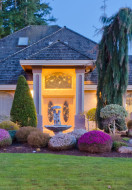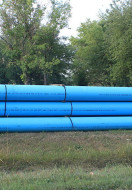Building Specs home inspections wants to supply you with more information on decks. This is an area where there are several recurring problems. A deck is subjected to extreme weather conditions, i.e. rain, snow, heat, sun, etc. and requires routine maintenance and inspection. The deck is an area where large numbers of people may congregate and subjected to large weight loads. An interior floor will usually have direct bearing points for the floor joist, where as a deck may be supported only by connectors, at the house and/or support post.
Quite commonly the ledger board is attached directly to the house, with no flashing or spacing to prevent water infiltration. This can lead to rot at the sill plate, bandboard, ledger, and/or siding. Water can also pocket which can freeze, and cause damage to the siding, even vinyl and aluminum.
There are some recommended methods to prevent this. One solution is a flashing cap. The flashing should go up under the siding at least several inches, angle out on top of the ledger, and bend down over the face of the ledger. This will force the water to run off and away from the siding. Another acceptable method is to space the ledger from the house, and fill the bolt holes with silicone or some other sealant prier to inserting the bolts. This will allow the water to drain between the deck and siding. An additional method is to build a free standing deck with no attachments to the house. Some houses are constructed with pre-engineered floor joist. Many times these floor systems will have a plywood or other non-dimensional framing band-board. In this instance a deck attached to the plywood is susceptible to failure, and potential collapse. This has been documented in many occurrences. Some areas are requiring a deck be independent of the house structure, and rest on independent supports and footings. Metal floor joist would also fall under this category.
Another serious problem is occurring concerns support posts and footings. When support post are put into the footing, and even the ground, they are prone to rot. Even pressure treated posts, including 6x6's may completely fail within a few years.
The problem occurs when the post is put into the ground, and concrete is poured around the post. Once the concrete has set, the post has established a pocket in which water can collect. The water is absorbed into the post and cannot dry out. In colder climates the water freezes and can crack the concrete. Additionally, the deck should be bearing on top of the footing and not in it. Some people are under the misconception that pressure treated wood will not rot.
One preferred method is to pour the footing either level or above the grade. Then using a positive connection, such as a galvanized anchor base, the post should be bolted or embedded in the concrete. This will elevate the post off of the ground, and out of the footing. This will prevent the wood's capillaries from wicking up water. In addition you will have direct bearing on the footing. It is also acceptable to pour a footing below the frost line, at least 8 thick; then sit the post on top of the concrete and tamp fill dirt around the post. This will allow the water to drain away from the post.
Some soils may still cause the post to rot, so the post need to be routinely monitored. If your posts are in poured concrete it is recommended to routinely inspect the post with a sharp probe
for any rot.
Other items to visually check for are a positive connection at the top and bottom of the stairs, to the deck or landing. Quite commonly the connections are inadequate. With notched stringers it is imperative to have the bottom section of the stringer, which is solid, to be connected to the deck. If you draw a parallel line with the top edge of the board, the connection should fall in the solid section of the board. Otherwise this connection is prone to failure due if the grain should crack or fail.
Also see if all of the railing and pickets are secure. We prefer to see the railing post through bolted. All railing should be bolted to the deck frame securely. On higher decks deck for a railing that will not allow a child to fall through. All pickets should be secure. A high deck with decking running perpendicular to the joist may be susceptible to shaking back and fourth. This may be due the lack of proper triangulation. A board fastened to the bottom of the joist from the ledger to the outside bandboard, can help stabilize the deck. Decking running on a diagonal can add a tremendous amount of triangulation to the deck.







